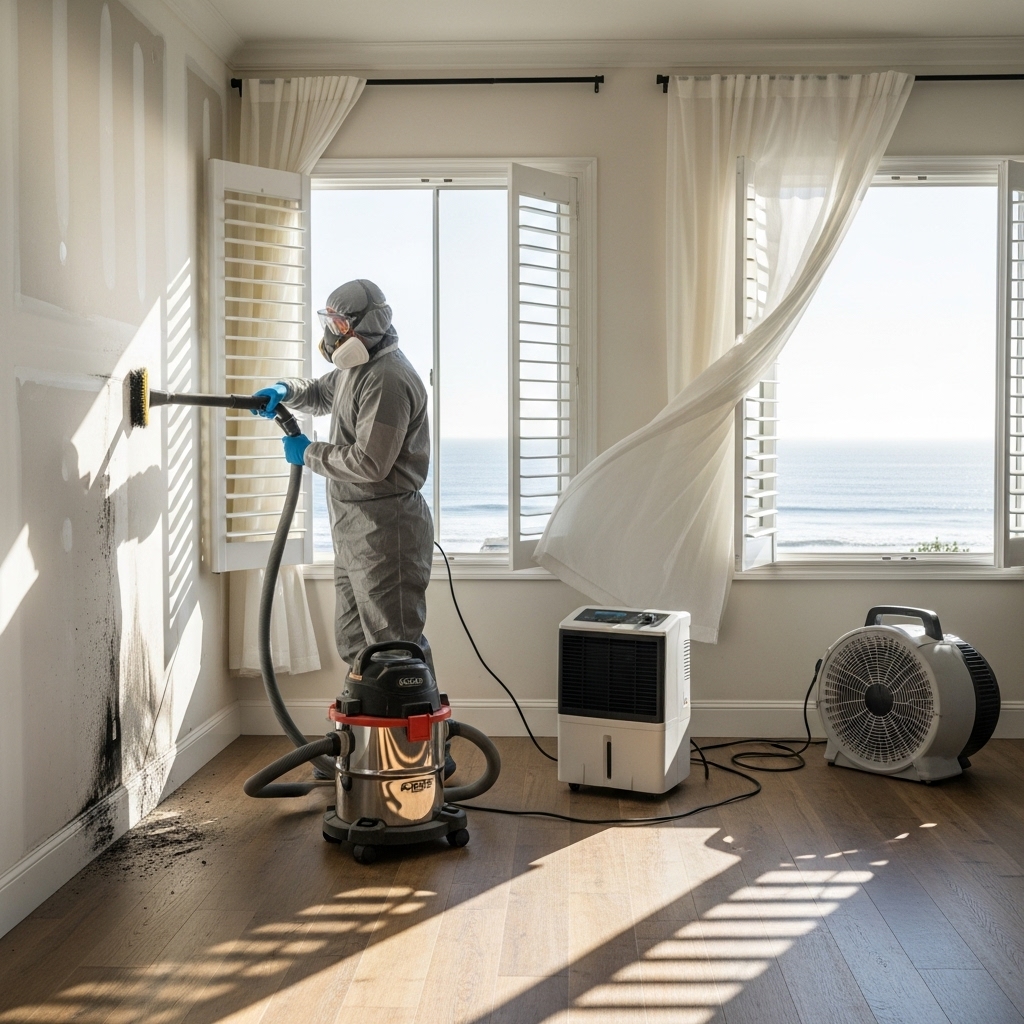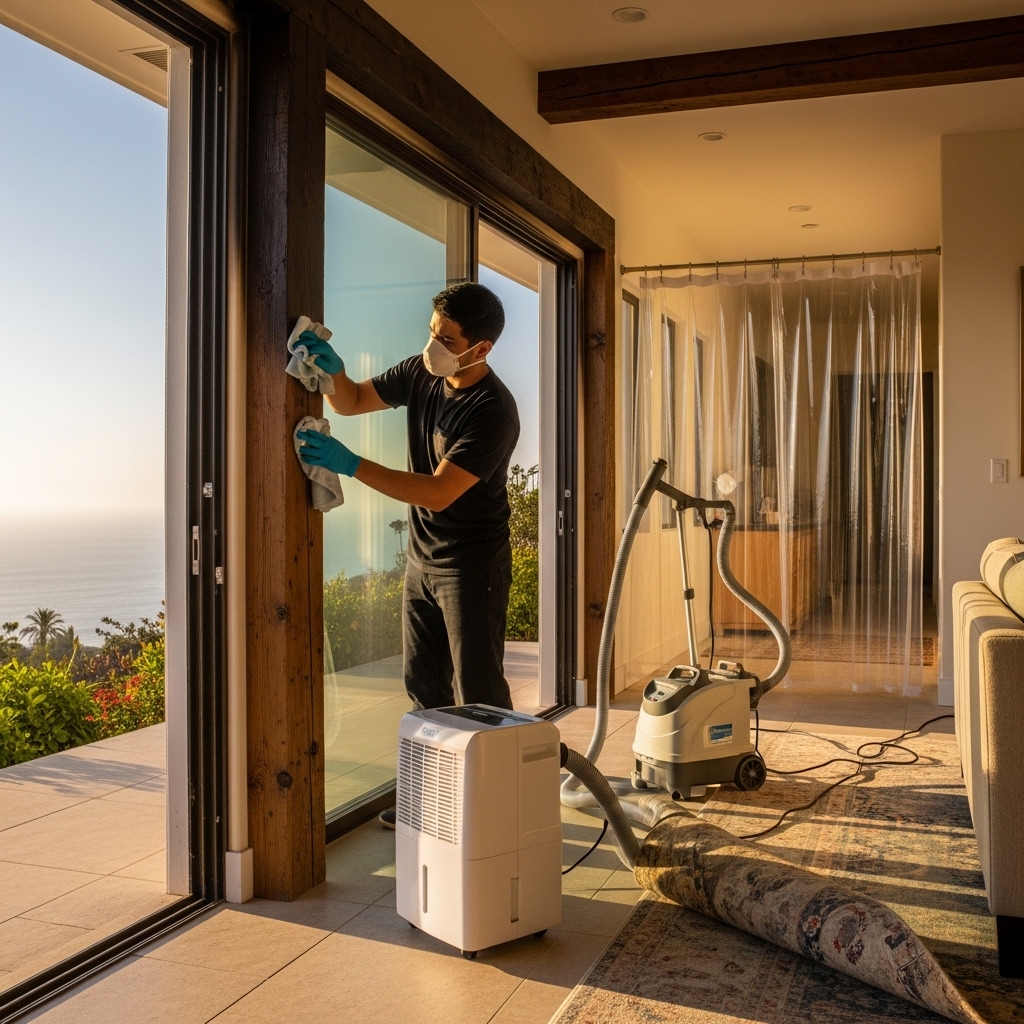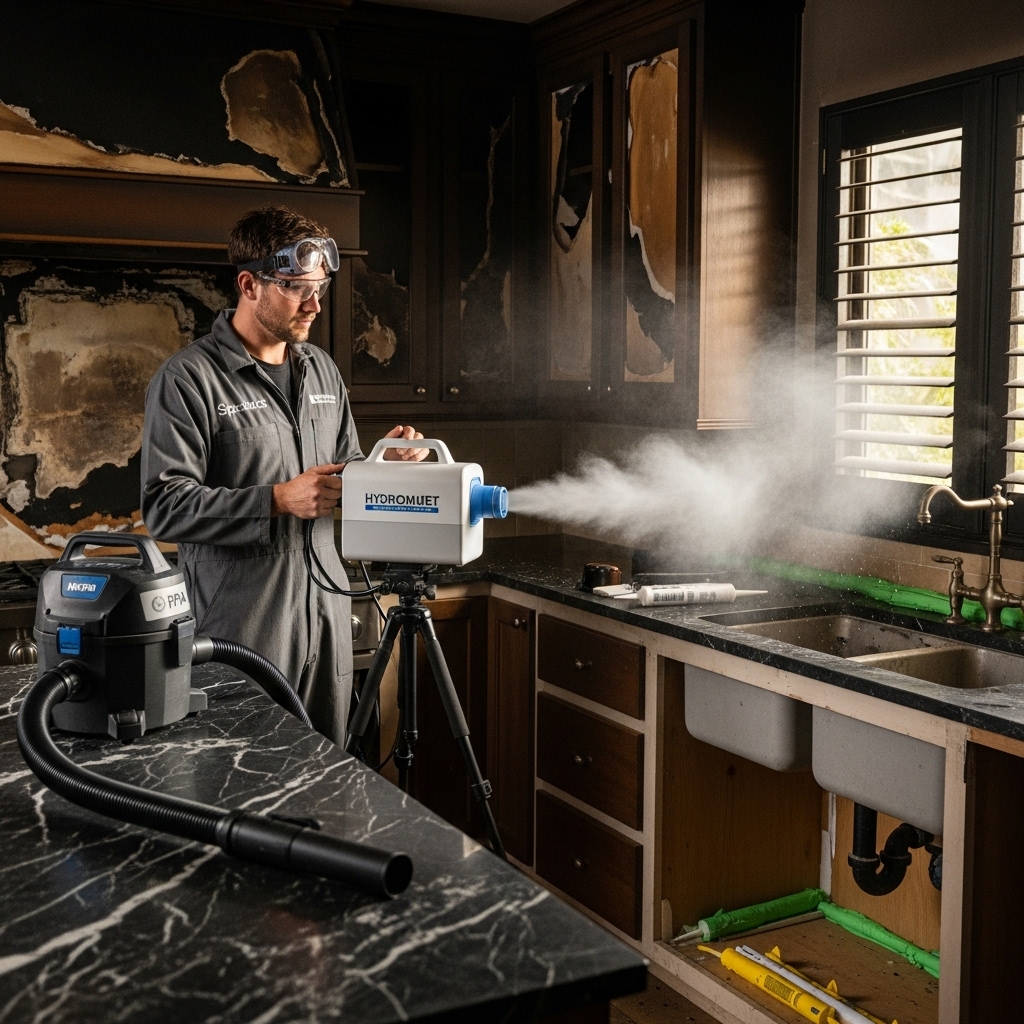Reclaiming your home after a fire in Malibu, California demands a clear plan, steady patience, and careful attention to detail. Whether the incident involved a small kitchen flare-up or a more widespread blaze, the right sequence of actions can protect your health, preserve valuables, and speed up recovery. In the introduction that follows, you will learn how to evaluate safety, understand the types of damage, and begin an effective cleanup. When professional help is needed, choosing experienced teams familiar with coastal humidity and local building practices can make a major difference in outcomes, and it helps to know what modern fire damage restoration entails before you begin.
Malibu, California’s warm climate and periodic storms can complicate post-fire recovery. The same coastal air that many people love also raises humidity levels, which accelerates corrosion on metal, encourages mold growth in damp materials, and can extend the time required for structural drying. Smoke residue can settle into porous surfaces quickly, and water used to extinguish flames can seep into hidden cavities. A thorough, methodical approach—from initial safety checks to final odor neutralization—helps ensure you do not simply mask damage but truly restore your space.
While the steps outlined here are detailed, remember that every fire scene is unique. The type of materials burned, the rooms affected, and how long the smoke lingered all influence your path. Use these guidelines as a comprehensive roadmap that you can adapt to your situation, and pay special attention to health and safety recommendations, especially if children, older adults, or pets live in the home.
Prioritize Safety Before Anything Else
Before reentering the property, confirm that it is safe to do so. If firefighters or inspectors have restricted access, respect their direction. Even after the flames are out, structural elements can be weakened, electrical hazards may remain, and air quality may still be poor. Keep protective gear on hand: sturdy shoes, gloves, eye protection, and masks rated for fine particulates and odors. If you cannot confidently confirm safety—especially around electrical systems—wait for a licensed professional to evaluate the property.
- Look for visible structural damage such as sagging ceilings, warped beams, or cracked masonry.
- Do not switch on lights or appliances until an electrician inspects the system for shorts or water intrusion.
- Ventilate the space by opening windows and doors when conditions allow, but avoid spreading soot by turning on central HVAC before inspection and filter changes.
- Keep children and pets away from affected areas until surfaces are cleaned and hazards removed.
Understand Fire, Smoke, and Water Damage
Fire damage is rarely limited to burned materials. Smoke and soot behave like a pervasive fog that moves through the smallest gaps, traveling to rooms far from the origin. You may find residue on ceilings, inside cabinets, and behind baseboards. Different smoke types—wet, dry, or protein-based—require different cleaning approaches. Water damage from firefighting efforts can be extensive as well, infiltrating insulation, subfloors, and framing. In Malibu, California, high ambient humidity can delay evaporation, so early and aggressive drying is essential to prevent mold growth and secondary damage.
Pay attention to odors. Persistent smoky smells point to soot embedded in porous materials such as drywall, upholstery, wood framing, and carpets. Addressing only the surface may temporarily lessen odor, but without deep cleaning and odor neutralization, the smell can return in humid weather or after you close up the house.
Document and Plan Your Restoration
Before moving or cleaning anything, document the scene thoroughly with photos and notes. Capture each room from multiple angles, close-ups of damaged items, and any water intrusion points. Keep a log of conversations with fire officials, contractors, and your insurer. This record will help you make decisions and, when applicable, support insurance claims. Next, create a phased plan that prioritizes stabilization (boarding up openings, tarping roofs, and shutting off utilities), followed by water extraction and drying, soot removal, odor control, and structural repairs.
- Assess structural safety and secure the property.
- Remove excess water and begin drying immediately.
- Isolate affected rooms to limit cross-contamination.
- Clean soot from top to bottom using appropriate methods.
- Deodorize with targeted techniques to treat both surfaces and air.
- Repair, replace, and repaint as needed.
Secure Openings and Protect the Interior
If windows broke or the roof was compromised, board up and tarp exposed areas quickly to deter trespassers, pests, and rain intrusion. Reinforce weak doors and fence off unsafe zones. When tarping the roof, ensure water sheds away from entries and walkways. Inside, cover undamaged furniture and floors with clean plastic to prevent soot fallout from resettling during cleanup.
Water Extraction and Structural Drying
Water removal is a race against the clock. Use wet vacuums to extract standing water and mops for smaller puddles. Pull baseboards and drill weep holes where necessary to allow moisture trapped behind walls to escape. Lift carpets and pad to dry subfloors; saturated carpet pads typically need replacement. Dehumidifiers and air movers work together to reduce ambient moisture and speed evaporation. In Malibu’s climate, consider desiccant dehumidifiers or continuous monitoring with hygrometers to maintain ideal humidity levels during drying.
- Measure moisture in walls, floors, and ceilings using a meter to set benchmarks.
- Run balanced air movement: too much airflow can spread soot; too little slows drying.
- Empty dehumidifier reservoirs frequently and ensure drainage lines are clear.
- Recheck moisture levels daily; continue until readings reach normal baseline for your materials.
Identify Soot Types and Clean Strategically
Not all soot is the same. Dry soot (from fast, high-heat fires) looks powdery and removes more easily with HEPA vacuuming before you wipe surfaces. Wet soot (from smoldering fires) is sticky, smear-prone, and requires specialized cleaners to break it down without driving it deeper into pores. Protein-based residues from kitchen fires may be nearly invisible but create stubborn odors and a thin, lacquer-like film. Always begin at the ceiling and work your way down so you do not contaminate cleaned areas.
- HEPA vacuum ceilings, walls, and trim to capture loose residue.
- Use dry cleaning sponges on flat-painted walls and ceilings; replace frequently as they load.
- For semi-gloss or gloss paints, a mild alkaline cleaner can help emulsify oily soot—test patches first.
- Avoid excessive water on drywall; wringing out cloths thoroughly reduces the risk of swelling or staining.
Contents Cleaning and Salvage Decisions
Sort belongings into three categories: restore, evaluate, and discard. Non-porous items (glass, metal, glazed ceramics) often clean well with mild detergent. Porous items (untreated wood, fabrics, paper) may require specialized treatment or off-site cleaning. Photograph each item before moving it and label boxes by room and category. When in doubt, set aside articles for professional evaluation, especially electronics, which can harbor corrosive soot.
For textiles, prompt laundering with appropriate additives can help, but repeated washing may be necessary to fully remove odor. Upholstered furniture benefits from HEPA vacuuming, followed by targeted cleaning methods based on the fabric. If cushion foam is saturated with smoke or water, replacement is usually the safest choice.
Odor Removal and Indoor Air Quality
Odor control must treat both surfaces and air. After physical cleaning, consider techniques such as thermal fogging or hydroxyl generation to neutralize lingering smells. Replace or upgrade HVAC filters and clean registers; avoid running the system until a professional checks for contamination and moisture in the ductwork. Place odor absorbers strategically, but remember that absorbers alone will not fix residues in materials. Good ventilation during cleanup helps disperse airborne particles and supports drying.
Electrical, Plumbing, and Structural Repairs
Heat can melt wire insulation, warp PVC pipes, and weaken lumber. Engage licensed professionals to inspect and repair mechanical systems. Framing members that are charred beyond a shallow depth may need replacement, while slightly affected lumber can sometimes be sanded, sealed, and reinforced. When repainting, use stain-blocking primers specifically labeled for smoke. Ensure new materials are fully dry before sealing them to avoid trapping odors.
Health Precautions During Cleanup
Even small fires release compounds that can irritate the lungs and skin. Wear protective masks or respirators appropriate for particulates and, when needed, for organic vapors. Avoid dry sweeping, which can put soot back into the air; instead, use HEPA vacuums. Wash hands frequently and keep a dedicated set of cleanup clothes that you launder separately. If you have respiratory conditions or sensitivities, consider reducing your time on-site and seek help for labor-intensive steps.
Working With Professionals
There is no shame in asking for expert help, especially for large losses, heavy soot, or water intrusion. Experienced teams bring industrial-grade extraction and drying equipment, advanced odor control methods, and a rigorous process tailored to the type of fire. They can also coordinate with your insurer, provide detailed moisture and progress reports, and help you decide what to salvage versus replace. If you are weighing options, review what modern fire damage restoration includes—assessment, containment, removal, cleaning, deodorization, and rebuild support—to determine which phases you want to handle and which to outsource.
Insurance, Permits, and Local Considerations
Contact your insurer as soon as you are safe and have preliminary documentation. Ask what inspections or estimates they require and whether they recommend vendors. Keep receipts for temporary lodging, supplies, and protective materials. In Malibu, California, local building codes may require permits for certain repairs, especially structural, electrical, and roofing work. Work with contractors who understand local regulations and can pull permits promptly, helping you avoid delays.
Preventing Future Fires
Once your home is on the mend, take steps to reduce risk. Test smoke alarms monthly and replace units and batteries as recommended by the manufacturer. Consider interconnected alarms so that if one detects smoke, all sound. Keep fire extinguishers rated for the risks in your home (for example, an appropriate unit in the kitchen) and train family members in their use. Plan and practice escape routes, and evaluate landscaping for defensible space if brush or vegetation surrounds the home.
- Maintain electrical systems; replace frayed cords and avoid overloading outlets.
- Keep cooking areas clean and never leave oils heating unattended.
- Store flammable materials in proper containers away from heat sources.
- Schedule professional dryer vent cleaning to remove lint buildup.
Creating a Recovery Timeline
Every restoration proceeds at its own pace, but setting expectations helps reduce stress. The first 48 hours usually focus on safety, stabilization, and water removal. The next week often involves thorough cleaning, ongoing drying, and preliminary repairs. Odor control may occur during and after cleaning, with painting and rebuilding following once moisture levels are normal. Communication with contractors and regular check-ins on progress keep the project moving and prevent small issues from turning into delays.
FAQs
Q: How soon should I start drying after a fire? A: Immediately. Water left in materials encourages mold and structural deterioration. Begin extraction and dehumidification as soon as authorities allow entry.
Q: Can I clean soot with household cleaners? A: Some surfaces respond to mild detergents, but always HEPA vacuum and use dry cleaning sponges first. Test cleaners in an inconspicuous spot to avoid smearing or staining.
Q: Will the smoke odor ever go away? A: Yes, with thorough source removal, proper cleaning, and targeted deodorization techniques, odors can be eliminated rather than masked.
Q: What items are typically unsalvageable? A: Charred structural elements beyond a shallow depth, heavily smoke-saturated porous items, and compromised electronics are common candidates for disposal.
Q: Should I run the HVAC system during cleanup? A: Not until it is inspected and filters are replaced. Running a contaminated system can redistribute soot and odors.
Q: How do I decide between DIY and hiring pros? A: Consider the fire’s size, the extent of water and smoke spread, your available time and equipment, and any health concerns. Large or complex losses benefit from professional involvement.
Move Forward With Confidence
Recovering from a fire in Malibu, California is challenging, but a structured plan keeps you moving toward a clean, safe home. Start with safety, stabilize the property, remove water, clean soot carefully, and neutralize odors before rebuilding. When you need expert guidance or advanced equipment, trusted specialists can help you complete each phase correctly and efficiently. For a clear picture of the process and support available, connect with professionals who focus on fire damage restoration and are ready to help you restore what matters.


